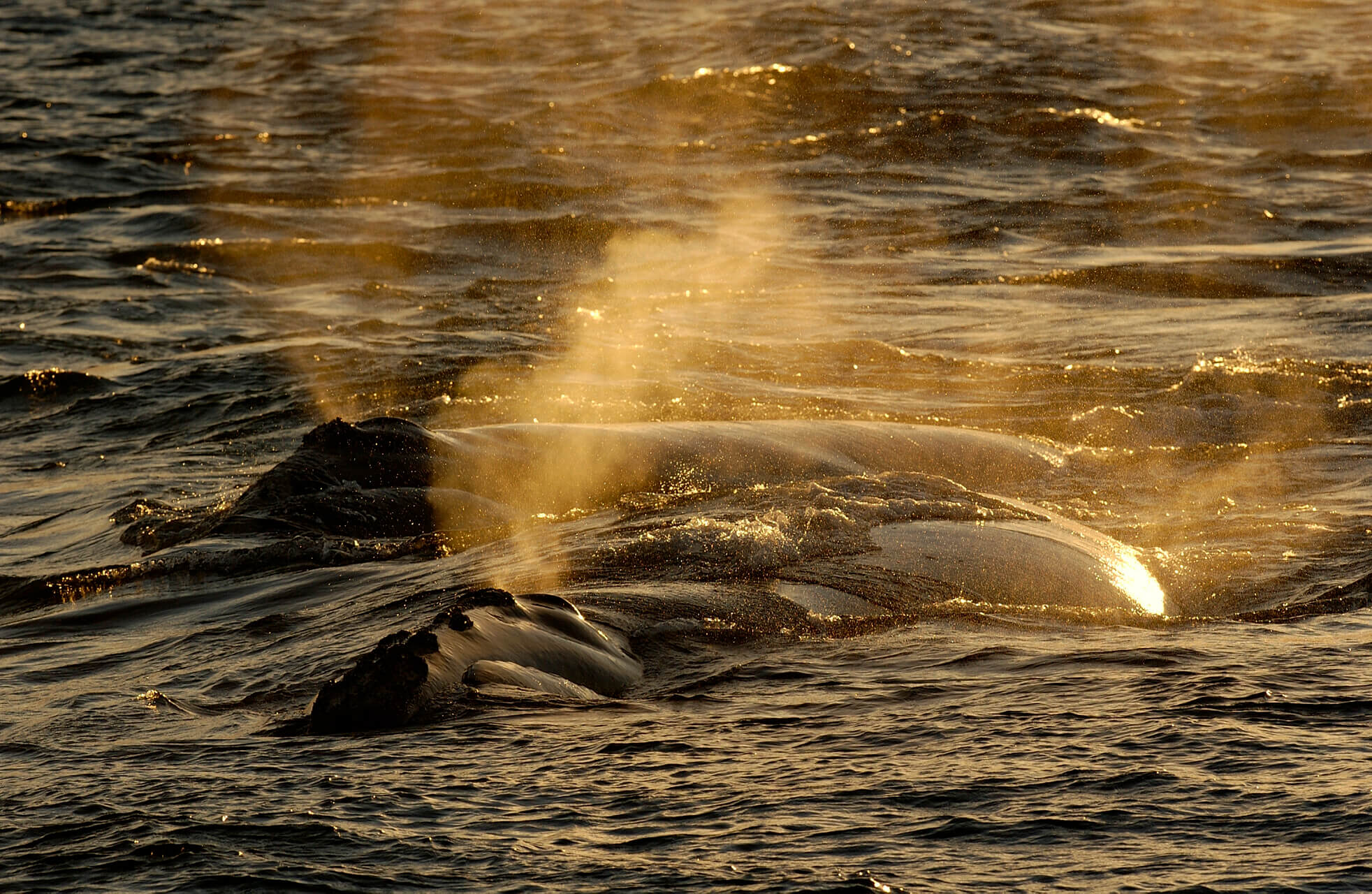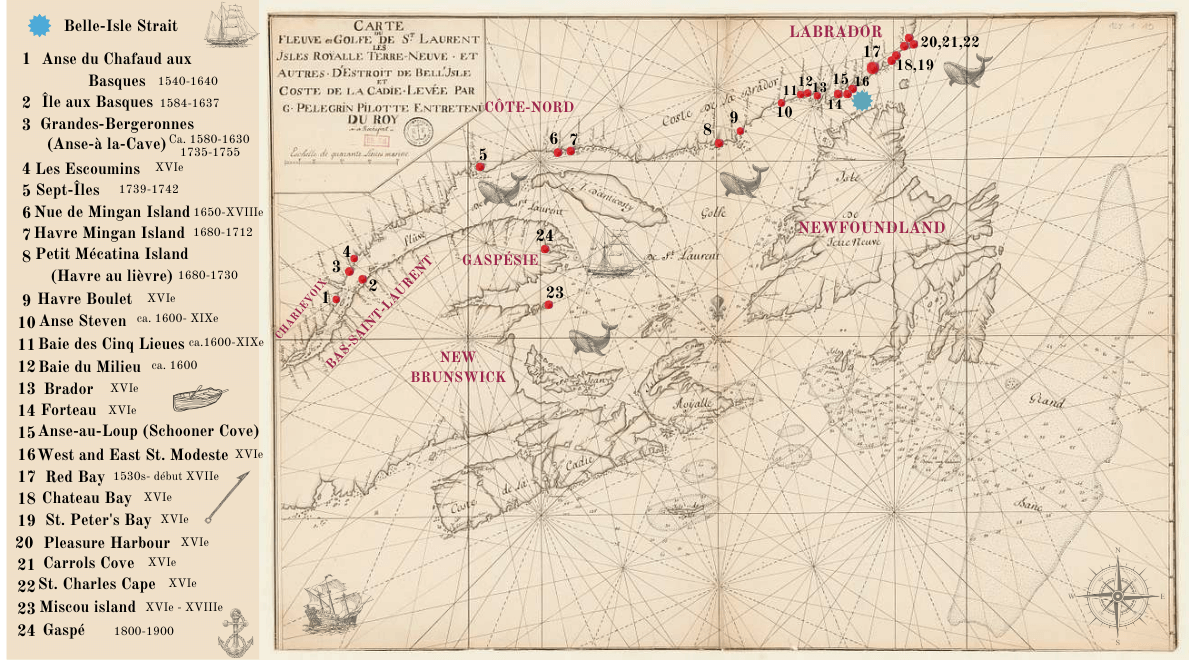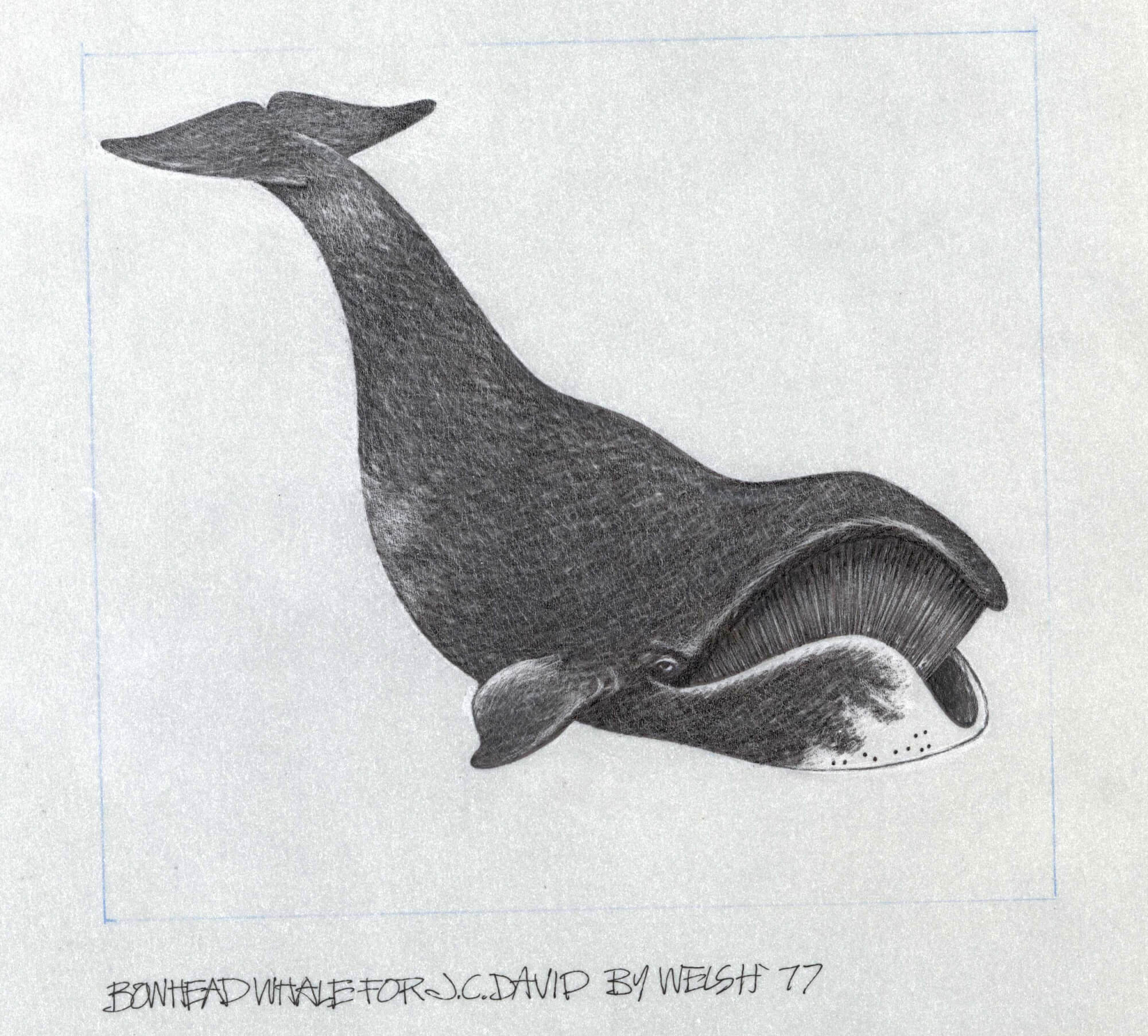Are we witnessing the return of the right whale to its ancestral territory?
For the past ten years plus, North Atlantic right whales have been visiting the Gulf of St. Lawrence in large numbers, gradually abandoning the Bay of Fundy, which was thought to be one of their essential habitats. Scientists agree that this change in distribution is being caused by a fluctuation in the distribution of this cetacean’s favourite prey: copepods. Historically, however, this whale’s presence in the St. Lawrence goes back centuries.
Right whale hunting in Quebec
Whales suffered greatly at the hands of the Basques, i.e. the inhabitants of a small region straddling France and Spain. As far back as the 11th century, the Basques had already been lucratively hunting grey whales with harpoons, followed by right whales, which they called Biscay whales or sardak baleac, i.e. “herding whales,” in the Bay of Biscay in the Atlantic. However, they depleted the stocks in this region in the 16th century.
The presence of the Basques in the Gulf of St. Lawrence is attested very early, i.e. between 1480 and 1530, during which period they were engaged in cod fishing. Their attention quickly turned to the many pods of whales that frequented the region. For entire seasons, the Basques settled in the waters of the Gulf of St. Lawrence and Newfoundland and it is estimated that around twenty to thirty “Biscayan” whaling ships and 2,000 sailors were present every summer! They were mainly interested in bowhead and right whales in the Strait of Belle Isle and even ventured into the St. Lawrence Estuary, including Les Escoumins, Île aux Basques and as far upstream as Île Chafaud aux Basques! In his article “L’exploitation des cétacés dans l’estuaire du Saint-Laurent: survol historique,” anthropologist Alain Bernard believes that it is highly likely that it was to pursue “one or both of these species that they carried out their fishing activities opposite Tadoussac circa 1580.” The few blubber ovens still present on Île aux Basques and Île Chafaud aux Basques bear witness to the presence of whalers and their quest for large whales.
Why right whales?
Technological limitations of the time meant that it was mainly slower-moving whales (e.g. right whales, bowhead whales) that could be targeted. For whalers operating out of small rowboats, these unsuspecting whales were easy to catch up to and harpoon. In 1610, Champlain describes how the Basques hunted whales in the estuary: “They finish it off, and when it is finally dead, it does not sink to the bottom of the sea.” The fact that a dead right whale will float (article in French) thanks to its thick blubber makes it easier to tow to shore at high tide. When the tide goes out again, the newly accessible carcass can be flensed and the blubber rendered into oil. Historically, whale oil was sold for use in lighting or for food, as a tool lubricant, and even for waterproofing and softening leather boots. The animals’ skin was used to make laces. Baleen was used to make clothing, chair springs, snuff boxes, and even hairbrush bristles!
Did you know? Bowhead whales were also in the St. Lawrence!
According to an 18th century document, the Basques believed that the Kamouraska region was a breeding ground for the bowhead whale, which at the time was known as the Grande Baye whale (in French) and nicknamed “the bearded one.” Grande Baye might have been a reference to the Gulf of St. Lawrence. The bowhead whale was likely the species most hunted (in French) by Basques in the St. Lawrence and especially in the Strait of Belle Isle. This species no longer frequents the region and its presence in these waters in the 16th century might have been favoured by the climate conditions of the Little Ice Age.
A seemingly inexhaustible resource
Historical accounts attest to the abundance of whales in the Gulf of St. Lawrence. In fact, they were so numerous that they even represented a navigational hazard. In his book, The Sea of Slaughter, Farley Mowat relates a number of testimonies of the time. In the 1600s, sailors estimated that whales were so numerous in the Gulf of St. Lawrence that they “became very tiresome to us and hindered our rest by their continuous movement and the noise of their spoutings.” An anonymous mariner in the mid-16th century recounts : “[T]he worst risk to navigation in the New Founde Land was not fog, ice, or uncharted rocks – it was whales of such size and in such numbers that collision with them was an ever-present danger.” In 1705, Sieur Courtemanche made a surprising observation: “On the north shore of the Gulf of St. Lawrence, whales were in such abundance that they came so close to land they could be harpooned from the rocks.”
End of an era
According to zooarchaeologists, it is assumed that between 12,000 and 15,000 right whales roamed Canadian and American waters in the 16th century, prior to the arrival of Europeans. Between 1530 and 1610, Basque whalers are said to have taken 300 to 500 right and bowhead whales annually for a total harvest of 25,000 or even as many as 40,000 animals. Beginning in 1600, the Basques abandoned Red Bay on the southern Labrador coast for reasons that are unclear, but which could be linked to a decline in whale stocks. The decline in right and bowhead whale populations may have begun as early as 1570! By 1620, Basque whaling in the Strait of Belle Isle was already a thing of the past, but the damage it left on the area’s biodiversity was clearly visible.
Right whales nearly extirpated in the St. Lawrence
With the arrival of Jacques Cartier and the beginning of the Basques’ departure, the European presence in the St. Lawrence brought with it barbaric, industrial-scale whaling. The rich fauna of the gulf and the estuary was overexploited to the point that certain species that had frequented these areas since deglaciation, including the right whale, were driven to the brink of extinction.
By the mid-19th century, right whales were becoming increasingly rare in the Gulf of St. Lawrence and the St. Lawrence Estuary. Nevertheless, whaling continued under the British regime, as American and Gaspésie-based whalers are known to have been present in the gulf. Those operating out of the Gaspé Peninsula, whose preferred targets were right whales, frequented the Strait of Belle Isle as well as the Gaspé and estuary area, but only sailed 6 or 7 ships even in the most prosperous years. Other species of cetaceans such as large rorquals would initially be targeted by whalers in the Gaspé Peninsula, and later by the intensive hunting of the 20th century ushered in by the advent of the exploding harpoon gun.
St. Lawrence ecosystem ravaged
Right whales were not the only victims of whaling: a significant portion of the biodiversity in the St. Lawrence was also lost. According to Farley Mowat, testimonies from the time attest that so many whales were being killed in the St. Lawrence that the local polar bear population skyrocketed, as these animals would routinely feed on the carcass remains of harvested whales. Polar bears were hunted until they were extirpated from Anticosti Island and the northern gulf in the 17th century, and later from the entire Labrador coast.
Huge colonies of walrus (in French) were once found scattered across the gulf and into the estuary. In less than two centuries, the St. Lawrence walrus populations of the St. Lawrence were decimated and completely wiped out of the region by the end of the 1700s. The great auk (Pinguinus impennis) (in French) was hunted so heavily that the species became extinct in 1844. Additionally, when he dropped anchor in a cove off Île aux Coudres in 1535, Jacques Cartier noted (web page in French) “an incalculable number of large [sea] turtles.”
Back to their roots
Whaling has had such a heavy impact on cetacean populations that it is possible that the collapse of certain populations has altered their migration routes. Does their reappearance mark the beginning of a return to their roots? We invite you to read more in the second part of this article, which discusses the return of right whales to their historical range.
Learn more :
- Alain Bernard. “L’exploitation des cétacés dans l’estuaire du Saint-Laurent: survol historique”. Présenté à la Colloque pluridisciplinaire d’Amérique et d’Atlantique.
- Farley Mowat. The Sea of Slaughter.















